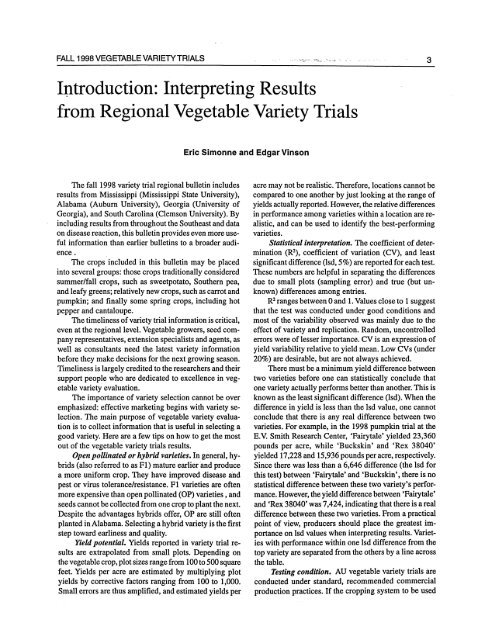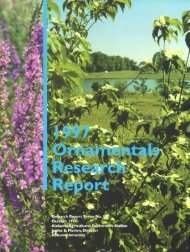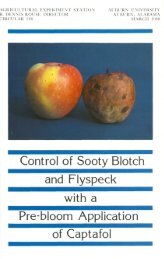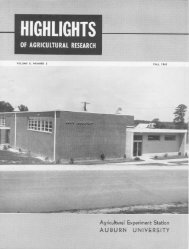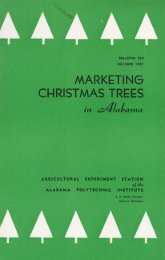FALL TRIALS 1998 VEGETABLE VARIETY - Auburn University
FALL TRIALS 1998 VEGETABLE VARIETY - Auburn University
FALL TRIALS 1998 VEGETABLE VARIETY - Auburn University
Create successful ePaper yourself
Turn your PDF publications into a flip-book with our unique Google optimized e-Paper software.
<strong>FALL</strong> <strong>1998</strong> <strong>VEGETABLE</strong> <strong>VARIETY</strong> <strong>TRIALS</strong> 3<br />
Introduction: Interpreting Results<br />
from Regional Vegetable Variety Trials<br />
The fall <strong>1998</strong> variety trial regional bulletin includes<br />
results from Mississippi (Mississippi State <strong>University</strong>),<br />
Alabama (<strong>Auburn</strong> <strong>University</strong>), Georgia (<strong>University</strong> of<br />
Georgia), and South Carolina (Clemson <strong>University</strong>). By<br />
including results from throughout the Southeast and data<br />
on disease reaction, this bulletin provides even more useful<br />
information than earlier bulletins to a broader audience<br />
.<br />
The crops included in this bulletin may be placed<br />
into several groups: those crops traditionally considered<br />
summer/fall crops, such as sweetpotato, Southern pea,<br />
and leafy greens; relatively new crops, such as carrot and<br />
pumpkin; and finally some spring crops, including hot<br />
pepper and cantaloupe.<br />
The timeliness of variety trial information is critical,<br />
even at the regional level. Vegetable growers, seed company<br />
representatives, extension specialists and agents, as<br />
well as consultants need the latest variety information<br />
before they make decisions for the next growing season.<br />
Timeliness is largely credited to the researchers and their<br />
support people who are dedicated to excellence in vegetable<br />
variety evaluation.<br />
The importance of variety selection cannot be over<br />
emphasized: effective marketing begins with variety selection.<br />
The main purpose of vegetable variety evaluation<br />
is to collect information that is useful in selecting a<br />
good variety. Here are a few tips on how to get the most<br />
out of the vegetable variety trials results.<br />
Open pollinated or hybrid varieties. In general, hybrids<br />
(also referred to as Fl) mature earlier and produce<br />
a more uniform crop. They have improved disease and<br />
pest or virus tolerance/resistance. F1 varieties are often<br />
more expensive than open pollinated (OP) varieties, and<br />
seeds cannot be collected from one crop to plant the next.<br />
Despite the advantages hybrids offer, OP are still often<br />
planted in Alabama. Selecting a hybrid variety is the first<br />
step toward earliness and quality.<br />
Yield potential. Yields reported in variety trial results<br />
are extrapolated from small plots. Depending on<br />
the vegetable crop, plot sizes range from 100 to 500 square<br />
feet. Yields per acre are estimated by multiplying plot<br />
yields by corrective factors ranging from 100 to 1,000.<br />
Small errors are thus amplified, and estimated yields per<br />
Eric Simonne and Edgar Vinson<br />
acre may not be realistic. Therefore, locations cannot be<br />
compared to one another by just looking at the range of<br />
yields actually reported. However, the relative differences<br />
in performance among varieties within a location are realistic,<br />
and can be used to identify the best-performing<br />
varieties.<br />
Statistical interpretation. The coefficient of determination<br />
(R 2 ), coefficient of variation (CV), and least<br />
significant difference (lsd, 5%) are reported for each test.<br />
These numbers are helpful in separating the differences<br />
due to small plots (sampling error) and true (but unknown)<br />
differences among entries.<br />
R 2 ranges between 0 and 1. Values close to 1 suggest<br />
that the test was conducted under good conditions and<br />
most of the variability observed was mainly due to the<br />
effect of variety and replication. Random, uncontrolled<br />
errors were of lesser importance. CV is an expression of<br />
yield variability relative to yield mean. Low CVs (under<br />
20%) are desirable, but are not always achieved.<br />
There must be a minimum yield difference between<br />
two varieties before one can statistically conclude that<br />
one variety actually performs better than another. This is<br />
known as the least significant difference (lsd). When the<br />
difference in yield is less than the lsd value, one cannot<br />
conclude that there is any real difference between two<br />
varieties. For example, in the <strong>1998</strong> pumpkin trial at the<br />
E.V. Smith Research Center, 'Fairytale' yielded 23,360<br />
pounds per acre, while 'Buckskin' and 'Rex 38040'<br />
yielded 17,228 and 15,936 pounds per acre, respectively.<br />
Since there was less than a 6,646 difference (the lsd for<br />
this test) between 'Fairytale' and 'Buckskin', there is no<br />
statistical difference between these two variety's performance.<br />
However, the yield difference between 'Fairytale'<br />
and 'Rex 38040' was 7,424, indicating that there is a real<br />
difference between these two varieties. From a practical<br />
point of view, producers should place the greatest importance<br />
on lsd values when interpreting results. Varieties<br />
with performance within one lsd difference from the<br />
top variety are separated from the others by a line across<br />
the table.<br />
Testing condition. AU vegetable variety trials are<br />
conducted under standard, recommended commercial<br />
production practices. If the cropping system to be used


